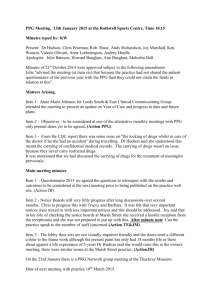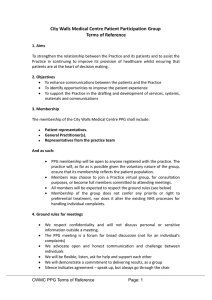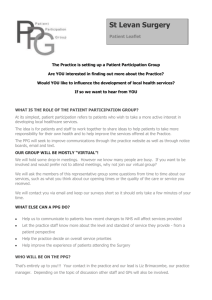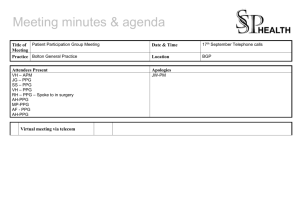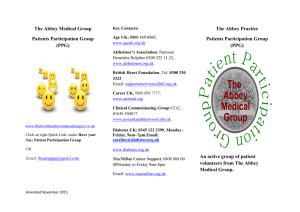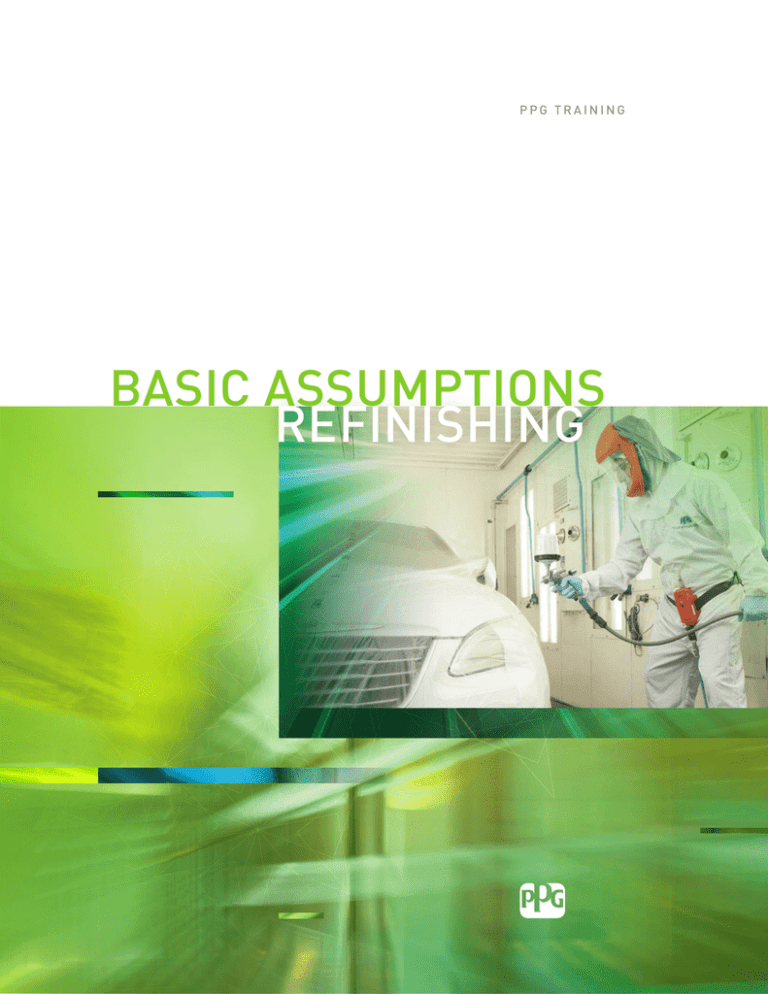
PPG TRAINING
basic assumptions
refinishing
PPG Industries Automo ve Refinish group makes these assump ons based on accepted industry prac ces, our knowledge, past experience and feedback from our employees and customers. These assump ons are intended to be used by collision repairers for reference and support documenta on to promote a be er understanding of the refinishing process to their customers. For complete informa on, please refer to the appropriate PPG or Nexa Autocolor technical data sheets. INDEX Section:
Page:
1.
Surface Preparation - Metal
Parts Removal Guidelines .................................................................... 1-1
2.
Surface Preparation - Plastic
Plastic Refinishing ............................................................................... 2-1
Facts on Bumper Color ........................................................................ 2-2
3.
Masking
Vehicle Masking Process (PD-0300) .................................................. 3-1
4.
Spray Equipment (no items for this category)
5.
Primer and Primer Surfacer Application
Primer Surfacer (PD-0520) .................................................................. 5-1
Pinchweld Priming Process with Epoxy - Air Dry (PD-0570AD) .......... 5-2
Pinchweld Priming Process with Epoxy - Force Dry (PD-0570FD) ..... 5-3
6.
Pre-Paint Preparation
Parts Edging - Internal Repair/Engine Bay ........................................... 6-1
Sprayout Cards .................................................................................... 6-2
Tri-Coat Let-Down Panels .................................................................... 6-3
7.
Paint Application Procedures
Primer Sealer (PD-0701) ..................................................................... 7-1
Single Stage ......................................................................................... 7-2
Basecoat Color ..................................................................................... 7-3
Clearcoat ............................................................................................. 7-4
8.
Finished Paint Procedures
© 2013 PPG Industries, Inc. All rights reserved.
The PPG logo is a trademark of PPG Industries Ohio, Inc.
Refinishing Assumptions rev. 6/13
Parts Removal Guidelines
Overview – When repairing to a factory-like finish, existing paintwork must be
thoroughly sanded and cleaned to ensure the adhesion of subsequent coatings.
Often times this is not feasible if moldings and parts are not removed.
1
When possible, PPG recommends that all parts be removed prior to
refinishing panels and blend areas.
If it takes the same time to remove a part as it does to tape the part,
remove it prior to refinishing.
2
Dropping bumper cover ends, rocker moldings and other types of trim can create
potential risks while moving a vehicle and require additional time to mask and secure
compared to removing the part. Partially attached components also can create issues
during the paint process. It is PPG’s recommendation to remove parts prior to
prepping and refinishing, especially if a partially attached component will impede work.
3
If the interior door panel must be removed as part of the repair operation,
remove whatever parts can be removed prior to painting the exterior.
4
If no gap exists between the part
and the panel (close-fitting part),
remove the part prior to
refinishing.
5
CAUTION – Manufacturer
warranty recommendations
supersede any PPG guidelines
shown above.
Example Areas © 2013 PPG Industries, Inc. All rights reserved.
The PPG logo is a trademark of PPG Industries Ohio, Inc.
Refinishing Assumptions rev. 6/13
Page 1 - 1
Plastic Refinishing
Overview – When repairing to a factory-like finish, the substrate being refinished
determines the process and products recommended. To reproduce the color, gloss
level, and texture of the factory finish on plastic parts requires a different process
than painting metal.
1
Successfully preparing plastic parts for painting requires more complete
scuffing/sanding and more thorough cleaning than what is needed for
metal parts. If water “sheets” off the part, then it is ready for paint. If
water “beads up” on the part, recleaning is necessary. There are special
cleaners designed specifically for this process.
2
When refinishing bare plastic, use the appropriate preparation products
and adhesion promoters to ensure a successful outcome. These
products are explained and demonstrated in our technical training
materials and courses.
3
Due to the nature of a flexible substrate, it must be able to absorb a slight
impact and not crack or chip. Additives are used in undercoats and
clearcoats to maintain this flexibility. Years ago, these additives were just
a solvent that would evaporate. Today, our flex additives contain resins
that actually remain with the paint film after any solvent has left. These
resins improve long-term flexibility and durability.
4
Basecoat film does not require flexing. However, to get the most durable
finish when painting flexible leading edges, a best practice is to activate
the basecoat (especially solvent).
5
PPG does not recommend using flexed materials to paint metal parts.
While compatibility and adhesion may be unaffected, there are three
reasons to avoid this practice: decreased productivity since the flexed
material takes a little longer to dry, the increased material costs of the
flex agent, and adding flex agent may result in VOC non-compliance.
6
Metal parts can be baked on or off the car with relative ease. Non-rigid
plastic parts, if baked off the car, must be adequately supported to avoid
warping and deforming of the part or baked longer at lower temperatures.
!
Note: Bumper failure due to poor preparation is NOT a warranty issue.
More attention to detail during preparation will reduce potential customer
satisfaction issues in the future.
© 2013 PPG Industries, Inc. All rights reserved.
The PPG logo is a trademark of PPG Industries Ohio, Inc.
Refinishing Assumptions rev. 6/13
Page 2 - 1
Facts on Bumper Colors
Overview – Sometimes the original bumper and accent pieces may not match the
factory’s vehicle body color even before the repair. In addition, sometimes even
metal and plastic pieces painted right next to each other at the same time and with
the same paint, may not match. Here are some possible explanations:
1
A color can vary depending on the substrate on which it is painted. For
example, the evaporation rates of paint and related products may vary
over metal or plastic. A longer rate gives a flake pigment additional time
to “settle” which often darkens the face of the color.
2
The body was painted on a
production line at the factory,
while other parts, such as the
bumper and trim pieces, may
be painted at another location
using a different application
method.
3
Slight adjustments can be
made during application
creating a lighter or darker
color, or causing the metallics
or mica elements to lay down
differently. A best practice is
to paint the bumper in the
same position that it will be
mounted on the vehicle.
4
Light reflects differently on
curved and flat surfaces
causing the appearance of a
color shift.
© 2013 PPG Industries, Inc. All rights reserved.
The PPG logo is a trademark of PPG Industries Ohio, Inc.
Refinishing Assumptions rev. 6/13
Page 2 - 2
PD‐0300 Vehicle Masking Process
Overview – The purpose of masking is to protect the undamaged areas of the vehicle
from overspray during the repair process.
Once priming is completed, it is a best practice to remove used masking materials
and replace prior to paint application. This will minimize dust in the paint area and in
the final finish.
Check repair order and verify proper repairs were made.
Verify that all parts to be painted are available and removed.
1
2
Visually inspect that:
All gloss has been removed from panels and edges.
All panels have been thoroughly cleaned using wax and grease
remover or waterborne cleaner. All openings blown with air.
Outline tape - Outline repair area to be painted using 1 ½ “ or 2”
tape. When possible, backtaping is preferred. Aperture tape
(foam tape) may be used when backtaping isn’t possible. Be
aware that bake cycles may cause foam tape to leave a residue
requiring additional cleanup and may also result in a more
noticeable paint edge.
Spray Mask - Spray mask may be used in conjunction with
plastic car covers. This adds additional protection reducing
chance of overspray on panels which are not being painted.
3
Plastic - Use paintable plastic sheeting to cover the rest of the
vehicle. Do not remove plastic from box. Use box as dispenser.
Place on floor and pull plastic over vehicle. Cut to fit and tape
edges.
Entryways - Attach 6” paper to all necessary backtaped edges
to help ensure a closed gap. This provides a second barrier to
backtaping alone and substantially reduces the risk of overspray.
Masking paper - Use masking paper on any areas not covered
with plastic.
Wheels - Mask wheels with paper back taped to wheel well.
Re-clean - Re-clean areas to be painted with wax and grease
remover or waterborne cleaner.
© 2013 PPG Industries, Inc. All rights reserved.
The PPG logo is a trademark of PPG Industries Ohio, Inc.
Refinishing Assumptions rev. 6/13
Page 3 - 1
PD‐0520 Spray Primer Surfacer Process
Caution: Wear the proper safety protection when sanding, cleaning, mixing and spraying all
materials included within this process.
1
2
3
4
5
6
7
Prepare surface as per process document PD-0100 Light Body Repair
Process.
8
9
10
Clean spray gun immediately following the application of the final coat
of primer.
Scuff sand all recessed areas and panel edges with red scuff pad for
adhesion of primer surfacer.
Apply Etching Primer to bare metal areas as per process document
PD-0500 Self-Etching Primer Process.
Clean area to be primed with Wax and Grease Remover and/or
SWX350 Waterborne cleaner and a clean cloth.
Mask as necessary to protect vehicle from overspray.
Mix Primer Surfacer according to product document.
Apply 2-3 coats of Primer Surfacer to the repair area.
a. Apply surfacer just beyond edges of repair area to minimize size.
b. Use reverse priming technique by covering the largest area with the
first coat and keep the following coats within that area.
c. Allow each coat of primer to flash to a uniformly dull appearance
before applying the next coat.
Allow the Primer Surfacer to air or force dry according to the product
document.
See process document PD-0590 Primer Surfacer Sanding Process
for next steps.
© 2013 PPG Industries, Inc. All rights reserved.
The PPG logo is a trademark of PPG Industries Ohio, Inc.
Refinishing Assumptions rev. 6/13
Page 5 - 1
PD‐0570AD Pinchweld Priming Process - Air Dry
Caution: Wear the proper safety protection when sanding, cleaning, mixing and
spraying all materials included within this process.
Overview – A two-component epoxy primer must be used on bare metal areas of
pinchwelds when installing stationary glass using urethane repair materials.
If corrosion is present or if sheet metal repairs or metal replacement are required, the
pinchweld flange must be primed in order to restore the bonding area strength.
1
2
3
4
5
6
7
8
9
Perform all necessary metal repairs to pinchweld areas on roof, pillar and
other panels where stationary glass will be installed.
Final sand all bare metal and body filler areas with 180 grit using a DA
sander. Do not apply body filler to pinchweld area.
Final sand and featheredge all adjacent painted areas with 320 grit on a
DA sander.
Clean area to be primed with Wax and Grease Remover and/or
SWX350 Waterborne cleaner and dry with clean towels.
Mask vehicle appropriately according to process document PD-0300
Vehicle Masking Process.
Mix DP50LF/DPL90LF (2:1 with DP402LF) OR
DP50LV/DP90LV Epoxy Primer according to the product document.
Apply two coats of DPLF OR DPLV Epoxy Primer to the repair area.
Allow each coat of DPLF OR DPLV Epoxy Primer to flash to a uniformly
dull appearance before applying the next coat.
Clean spray gun immediately following the application of the final
coat of DPLF OR DPLV Epoxy Primer.
10
Allow the DPLF OR DPLV Epoxy Primer to air dry overnight before
applying the urethane adhesive. However, the refinishing process can
continue once the epoxy can be masked without tape tracking.
11
IMPORTANT STEP – Mask off primed pinchweld area before color and
clearcoat application. Windshield adhesive must only be applied to a
clean, epoxy-primed surface.
© 2013 PPG Industries, Inc. All rights reserved.
The PPG logo is a trademark of PPG Industries Ohio, Inc.
Refinishing Assumptions rev. 6/13
Page 5 - 2
PD‐0570FD Pinchweld Priming Process - Force Dry
Caution: Wear the proper safety protection when sanding, cleaning, mixing and
spraying all materials included within this process.
Overview – A two-component epoxy primer must be used on bare metal areas of
pinchwelds when installing stationary glass using urethane repair materials.
If corrosion is present or if sheet metal repairs or metal replacement are required, the
pinchweld flange must be primed in order to restore the bonding area strength.
1
2
3
4
5
6
7
8
9
Perform all necessary metal repairs to pinchweld areas on roof, pillar and
other panels where stationary glass will be installed.
Final sand all bare metal and body filler areas with 180 grit using a DA
sander. Do not apply body filler to pinchweld area.
Final sand and featheredge all adjacent painted areas with 320 grit on a
DA sander.
Clean area to be primed with Wax and Grease Remover and/or
SWX350 Waterborne cleaner and dry with clean towels.
Mask vehicle appropriately according to process document PD-0300
Vehicle Masking Process.
Mix DP50LF/DPL90LF (2:1 with DP402LF) OR
DP50LV/DP90LV Epoxy Primer according to the product document.
Apply two coats of DPLF OR DPLV Epoxy Primer to the repair area.
Allow each coat of DPLF OR DPLV Epoxy Primer to flash to a uniformly
dull appearance before applying the next coat.
Clean spray gun immediately following the application of the final
coat of DPLF OR DPLV Epoxy Primer.
10
Force dry the DPLF OR DPLV Epoxy Primer using an IR light at full
power for 15 minutes or bake for 30 minutes after metal temperature
reaches 140°F. Allow pinchweld flange to cool to room temperature
before proceeding.
11
IMPORTANT STEP – Mask off primed pinchweld area before color and
clearcoat application. Windshield adhesive must only be applied to a
clean, epoxy-primed surface.
© 2013 PPG Industries, Inc. All rights reserved.
The PPG logo is a trademark of PPG Industries Ohio, Inc.
Refinishing Assumptions rev. 6/13
Page 5 - 3
Parts Edging & Cut-In Options
Overview—When repairing to a factory-like finish, sometimes a body color or an
engine bay color is required to match the OEM gloss level and performance
capability. To achieve these characteristics, consider one of the options listed
below.
Verify the appropriate color needed by referencing the PPG PAINTMANAGER®
software, a chromatic variant deck or an engine bay deck.
1
Internal Repair (Engine Bay) System: Designed to provide a
simple repair process where there is a specific underhood color or
where the internal area is a low gloss version of the exterior color.
Dedicated formulas are provided as part of the PPG color retrieval
system. They are designed to match the OE finish on internal,
unexposed parts.
2
Solvent Basecoat: Catalyze basecoat and apply to underhood and
other interior areas. Do not apply clearcoat.
3
Waterborne Basecoat: Exterior colors can be converted into a low
gloss internal repair (engine bay) color. For ENVIROBASE® High
Performance basecoat, see EB-145 and for AQUABASE® Plus
basecoat, see PDS N5.2.1.
4
Basecoat/Clearcoat: Apply appropriate basecoat color. Match the
factory gloss level using a full gloss clearcoat, a matte finish
clearcoat or a clearcoat mixed with matting base.
© 2013 PPG Industries, Inc. All rights reserved.
The PPG logo, Envirobase, Aquabase, and PaintManager are
trademarks of PPG Industries Ohio, Inc.
Refinishing Assumptions rev. 6/13
Page 6 - 1
Sprayout Cards
Overview - PPG has sprayout cards available that simulate
the various shades of gray sealers (Part #: ARMC464) . They
assist the refinish technician to achieve a blendable color
match.
Multiple sprayout cards might be used during this process.
Tinting is a dynamic operation and the time required to
achieve a blendable match may vary from color to color.
1
Mask off 3 or 4 sections along the length (leaving one section
exposed). Spray your first coat of base. Remove the next layer of
masking and apply a second coat. Repeat the process until you have 3
or 4 coats of color on the card.
!
Waterborne metallic and pearl colors will
also require the “Control Coat” application
to achieve the proper color alignment.
2
Clear the entire card using the same
clear and reduction that you will use to
make the repair.
3
When you compare the card to the
vehicle, you will be able to determine the
proper undertone and number of coats of
color that will need to be applied.
PPG recently released new G-Shade specific
sprayout cards. They are available through your
local distributor. Part numbers are:
!
ARMC464G1
ARMC464G3
ARMC464G5
ARMC464G6
ARMC464G7
© 2013 PPG Industries, Inc. All rights reserved.
The PPG logo is a trademark of PPG Industries Ohio, Inc.
Refinishing Assumptions rev. 6/13
Page 6 - 2
PD‐0660 Tri-Coat Color Letdown Panel
Caution: Wear the proper safety protection when sanding, cleaning, mixing and
spraying all materials included within this process.
1
2
Obtain OEM Color Code from vehicle and look up the code in PPG’s
PAINTMANAGER® software.
3
4
The groundcoat - main layer color in this process must be a good match to
the OEM color to continue.
Note any variant colors available, check variant colors using PPG variant
deck chips against area to be painted on the vehicle, choose prime or
variant color with best match.
Prepare the tri-coat letdown panel as shown below. Apply the
recommended shade of gray sealer for the groundcoat - main layer color to
the letdown panel first.
COMPLETED LET DOWN PANEL
3. Clearcoat only ½ of panel to
highlight differences in midcoat.
2. Mask off 5 horizontal sections of the panel.
Apply 5 coats of midcoat to entire panel,
removing 1 section of masking after each coat.
5 COATS OF MIDCOAT
4 COATS OF MIDCOAT
3 COATS OF MIDCOAT
2 COATS OF MIDCOAT
1 COAT OF MIDCOAT
APPLY GROUNDCOAT - MAIN LAYER TO ENTIRE PANEL
1. Apply “blendable” groundcoat - main layer to entire letdown panel.
International Training Program
Module SEL_SAL_xyz Page 2
5
6
© PPG Industries
Issue 1 - 04/03
Use the panel to determine the number of coats of mid-coat color for the
best match.
Follow the tri-coat blending process document PD-0710 Tri-Coat Color
Blending Procedure.
© 2013 PPG Industries, Inc. All rights reserved.
The PPG logo and PaintManager are trademarks of
PPG Industries Ohio, Inc.
Refinishing Assumptions rev. 6/13
Page 6 - 3
PD‐0701 Primer Sealer Application Process
Use of a wet-on-wet sealer (WOW) can be beneficial to improve adhesion to the substrate and increase chip resistance.
When applying low opacity colors over primer sealer, the appropriate shade of spectral gray may result in better color
alignment. Although optional in many repair scenarios, a WOW sealer is required over e-coated parts.
Caution: Wear the proper safety protection when sanding, cleaning, mixing and
spraying all materials included within this process.
1
2
3
4
Review work order to verify all work has been properly completed to
this point.
Verify that all parts to be sealed are available.
Clean area to be sealed with Wax and Grease Remover and/or
SWX350 waterborne cleaner and dry with clean towels.
Mask vehicle appropriately according to process document PD-0300
Vehicle Masking Process.
Apply a medium wet coat of Primer Sealer to the repair area. (Refer
to the Product Document for the sealer application instructions).
5
a. Keep the sealer application area as small as possible on spot
repairs.
b. Use the recommended G1 - G7 spectral gray sealer for the color
that will be applied.
6
Allow each coat of sealer to flash to a uniformly dull appearance
before applying the next coat.
7
Where repair areas are too tight to allow proper softening of the
sealer edge by the technician’s application technique, the entire
panel should have sealer applied.
8
9
Clean spray gun immediately following the application of the final
coat of sealer.
Allow the primer sealer to air dry according to the product document
before applying basecoat.
© 2013 PPG Industries, Inc. All rights reserved.
The PPG logo is a trademark of PPG Industries Ohio, Inc.
Refinishing Assumptions rev. 6/13
Page 7 - 1
Single Stage
Overview - Some manufacturers use a single stage product for the vehicle body. This
describes a product that has color and clear properties in one package. Since the product is
handled similarly to clearcoat and to repair to a factory-like finish, collision centers must
match the OE finish which may raise the following concerns.
1
FULL PANEL: Some car companies have specific procedures for warranty
repairs when refinishing an OEM single stage where no definite break line
exists for stopping the paint. To meet this OEM warranty guideline and for
PPG Lifetime Limited Paint Performance Guarantee purposes, the single
stage application must extend to the nearest panel edge or break point.
2
BLENDING: PPG does document a single stage blending procedure.
However, this procedure was designed for specific, economical repairs.
Due to its nature, the single stage blend edge is not durable enough to
withstand weathering, repeated exposure to the elements and becomes
visible after a period of time. As a result, for OEM warranty and PPG
guarantee purposes, blending a single stage edge is not recommended.
!
GUARANTEE: Are Single Stage blends guaranteed under PPG’s lifetime
guarantee? By the definitions above, only full panel application is covered.
Single stage blends are not covered under the PPG Lifetime Limited Paint
Performance Guarantee .
© 2013 PPG Industries, Inc. All rights reserved.
The PPG logo is a trademark of PPG Industries Ohio, Inc.
Refinishing Assumptions rev. 6/13
Page 7 - 2
Basecoat Color
Overview - Vehicle manufacturers select colors years before the actual vehicles are painted
at the factory. Once these model year colors are selected, they are provided to paint
manufacturers. PPG creates formulas to match these standards. There are many steps to
the manufacturing process and variations can occur throughout. They may be due to one
step being out of tolerance or a culmination of many steps being close to unacceptable.
Examples of these potential variations include different paint manufacturers supplying the
OE plant, different application equipment used at the factory, shearing of metallics as they
tumble through the supply line, parts painted separate from the vehicle body, to name a
few. The end result is that the actual car color does not match the OE standard.
1
TINTING: When the actual vehicle color does not match the OE standard
and is not close enough to blend, the paint formula needs to be adjusted to
get the color closer. This process, commonly referred to as tinting, is one
of the most difficult tasks a paint technician performs during the repair.
When tinting colors, there are five areas that the painter must balance:
hue/color, value/lightness, chroma/richness, metallic size, and flop/angle
perspective. It is a time-consuming process and rarely results in an exact
match due to the variables described above. Therefore, PPG recommends
tinting only to get the color to a blendable match.
2
SPOT REPAIR: When performing a spot repair, the idea is to minimize the
repair area. The repair area receives full coverage and the surrounding
area receives partial coverage creating an undetectable color transition.
The entire repaired panel is clearcoated. If there is not enough room
between the repair area and the adjacent panel(s), the color must be
blended onto the adjacent panel. All panels that are painted should be
clearcoated in their entirety.
3
FULL PANEL: When replacing a panel, blending color onto the adjacent
panel(s) is a necessary operation that results in an undetectable color
transition. If a spot repair occurs close to a panel edge, the color should be
blended onto the adjacent panel(s) as well. All panels that are painted
should be clearcoated in their entirety.
© 2013 PPG Industries, Inc. All rights reserved.
The PPG logo is a trademark of PPG Industries Ohio, Inc.
Refinishing Assumptions rev. 6/13
Page 7 - 3
Clearcoat
1
FULL PANEL: Some car companies have specific procedures for
warranty repairs when refinishing an OEM clearcoat where no definite
break line exists for stopping the clear. To meet this OEM warranty
guideline and for PPG Lifetime Limited Paint Performance Guarantee
purposes, the clearcoat application must extend to the nearest panel
edge or break point.
2
FILM BUILD: For PPG Lifetime Limited Paint Performance Guarantee
purposes, the clearcoat must cover the basecoat by a minimum of 2.0
dry mils after sanding, buffing, and polishing.
3
BLENDING: PPG does document a clearcoat blending procedure.
However, this procedure was designed for specific, economical repairs.
Due to its nature, the clearcoat blend edge is not durable enough to
withstand weathering, repeated exposure to the elements and becomes
visible after a period of time. As a result, for OEM warranty and PPG
guarantee purposes, blending a clearcoat edge is not recommended.
4
See the specific clearcoat product data sheet and/or PD-0730 for further
information.
© 2013 PPG Industries, Inc. All rights reserved.
The PPG logo is a trademark of PPG Industries Ohio, Inc.
Refinishing Assumptions rev. 6/13
Page 7 - 4
PD‐0800 Paint Defect Removal
Caution: Wear the proper safety protection when sanding, cleaning, mixing and
spraying all materials included within this process.
1
2
3
Assess the damaged area to look for dust nibs, runs, sags or other
refinish defects.
4
Runs/sags:
Clean area with an All Purpose Cleaner and Degreaser
Dust Nibs:
a. Sand nib with P1500 grit using a finishing DA sander and interface
backup pad taking care that 2.0 minimum dry film thickness of
clearcoat is maintained. Visual and hand check area to make sure
nib is removed.
b. Refine entire sanded area with P2000-P3000 damp on a DA
sander with a backup pad.
c. Proceed to the compounding procedure below.
a. Use P1200 grit Wet-or-Dry sandpaper with hand block to remove
the defect.
b. Refine entire sanded area with P1500 using a DA sander with an
interface pad.
c. Refine entire sanded area with P2000-P3000 damp on a DA
sander with a backup pad.
d. Proceed to the compounding procedure below.
5
Cosmetic scratches in OE finishes (not freshly repaired paint
finishes) can be compounded using the procedure below.
6
Compound the entire repair area with extra cut compound using a foam
pad or a wool compounding pad.
7
Polish the entire repair area with a swirl mark remover and a polishing
pad.
© 2013 PPG Industries, Inc. All rights reserved.
The PPG logo is a trademark of PPG Industries Ohio, Inc.
Refinishing Assumptions rev. 6/13
Page 8 - 1

